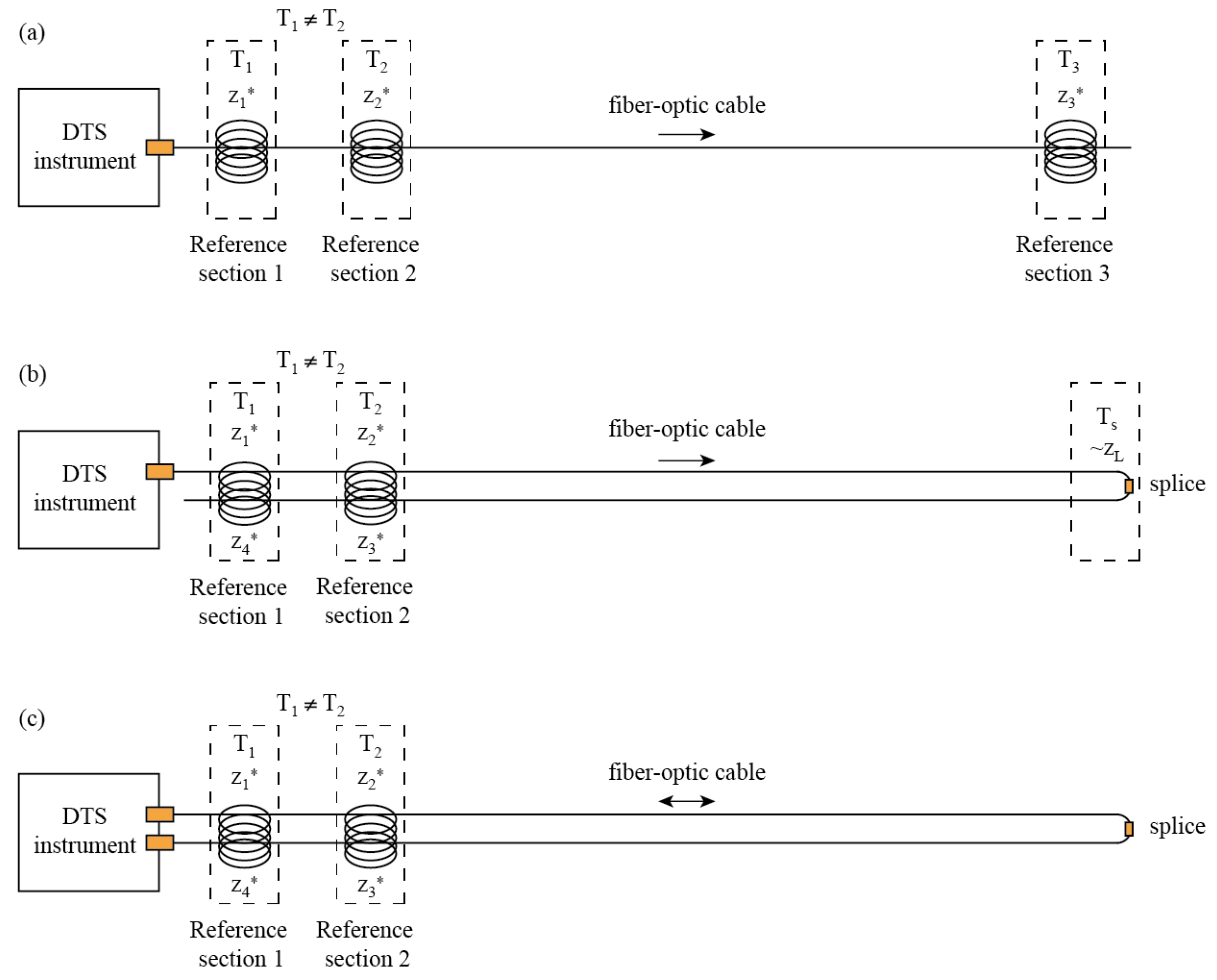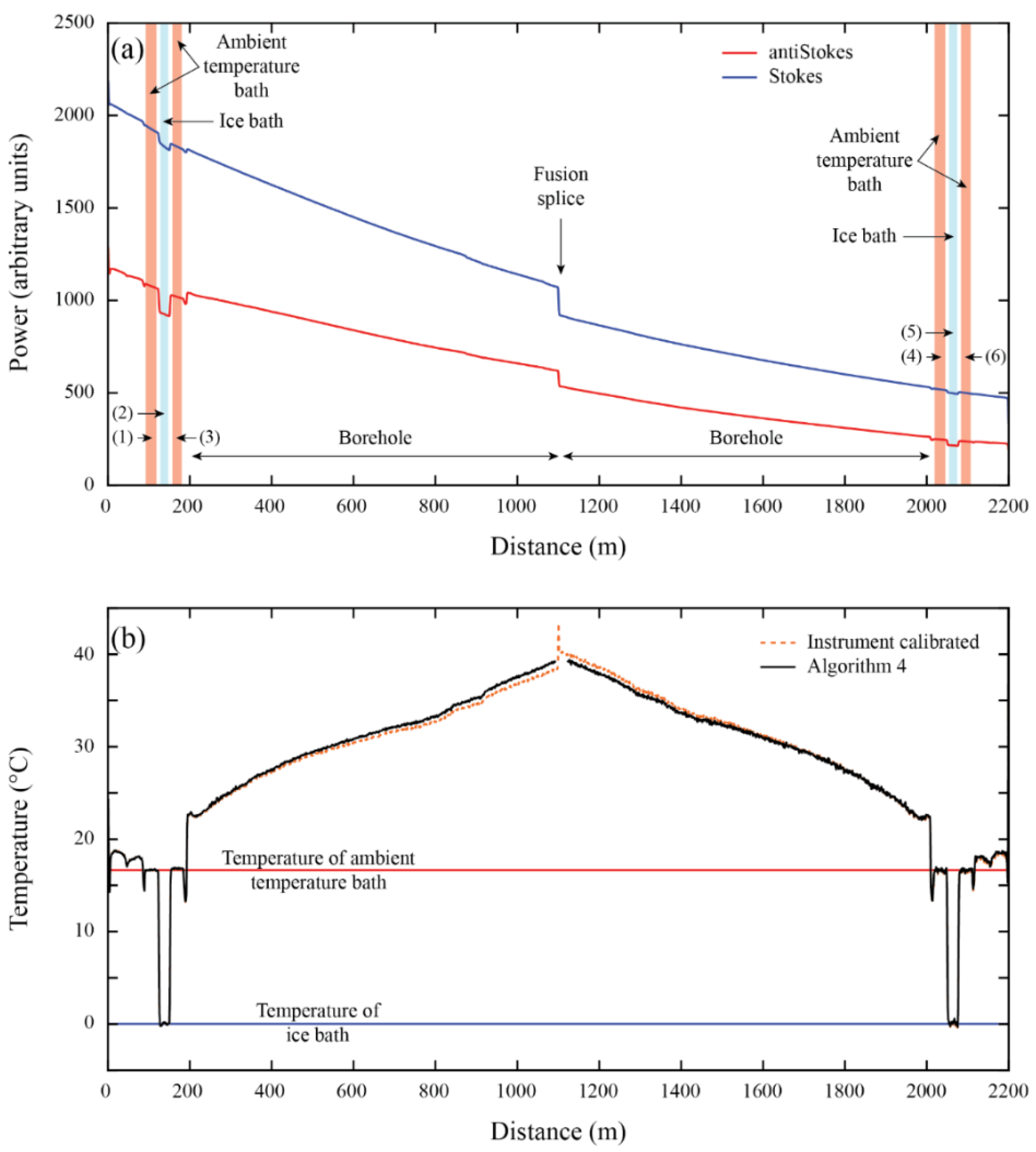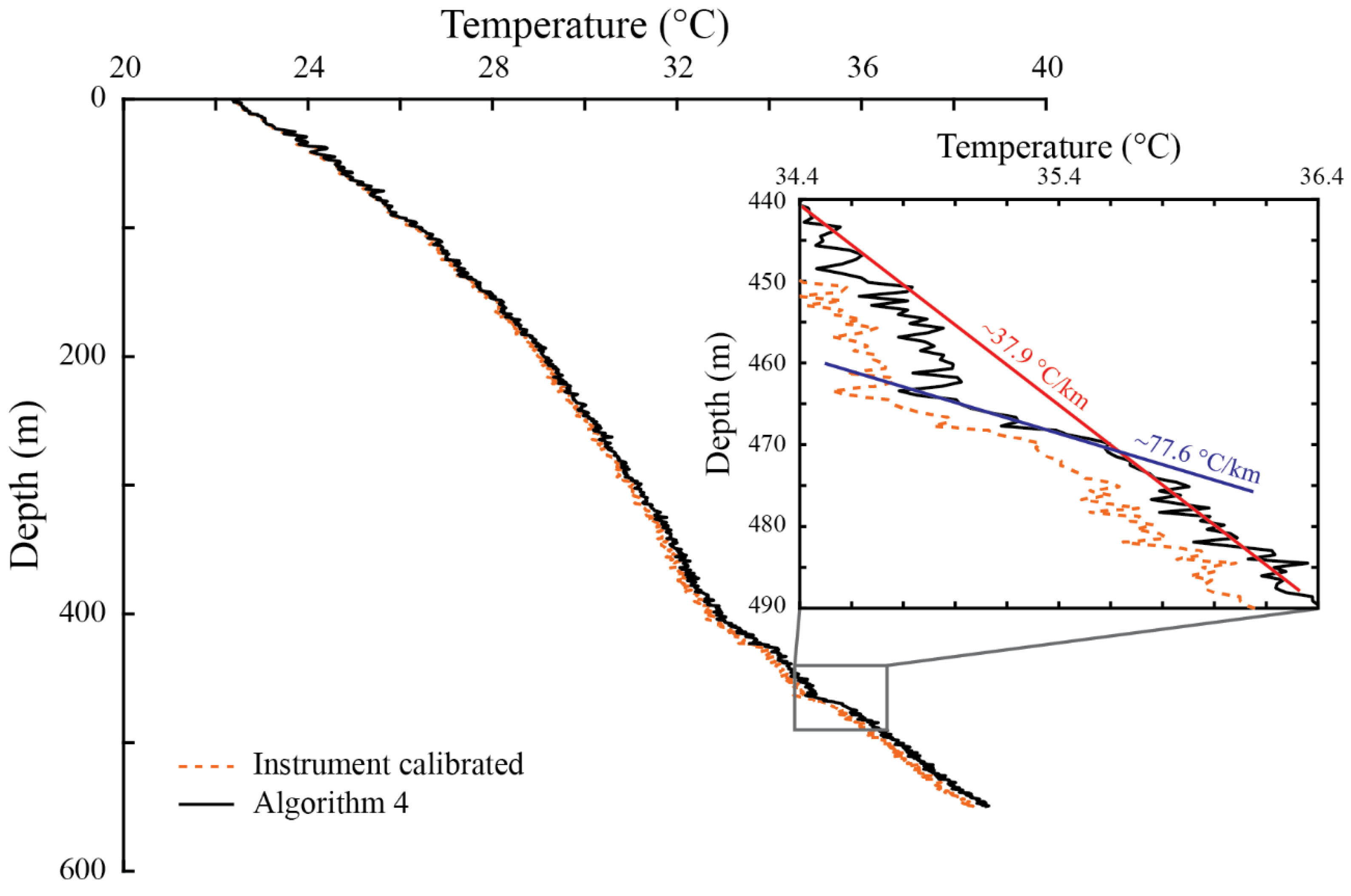Extension of Duplexed Single-Ended Distributed Temperature Sensing Calibration Algorithms and Their Application in Geothermal Systems
Abstract
1. Introduction
2. Raman Spectra DTS Theory
2.1. DTS Configurations and Current Calibration Algorithms
2.2. Extended Calibration Algorithms
2.2.1. Calibration by Sections (Algorithm 2)
2.2.2. Explicit Calibration Using Two Differential Attenuations (Algorithm 3)
2.2.3. Explicit Calibration Using Two Differential Attenuations and Two (Algorithm 4)
2.2.4. Explicit Calibration Using Two Differential Attenuations and Two C (Algorithm 5)
3. Materials and Methods
3.1. Laboratory Experiment
3.2. Field Evaluation
3.2.1. Boreholes in Northern Chile: Revisiting Geothermal Gradients Using Single- and Double-Ended Data
3.2.2. Borehole in the Chilean Central Andes: Geothermal Gradient
3.3. Calibration and Validation Metrics
4. Results and Discussion
4.1. Laboratory Experiment and Selection of the Best Algorithm
4.2. Field Evaluation
4.2.1. Boreholes in Northern Chile: Revisiting Geothermal Gradients Using Single- and Double-Ended Data
4.2.2. Borehole in the Chilean Central Andes: Geothermal Gradient
4.3. Limitations of the Proposed Extended Algorithms
5. Conclusions
Author Contributions
Funding
Institutional Review Board Statement
Informed Consent Statement
Data Availability Statement
Conflicts of Interest
Appendix A
| Algorithm | C1 (-) (Range) | C2 (-) (Range) | γ1 (K) (Range) | γ2 (K) (Range) | Δα1 × 105 (m−1) (Range) | Δα2 × 105 (m−1) (Range) |
|---|---|---|---|---|---|---|
| 1 | 1.083 ± 0.002 (1.081 to 1.086) | – | 483.2 ± 0.4 (482.8 to 483.6) | – | 8.007 ± 0.048 (7.959 to 8.055) | – |
| 2 | 1.083 ± 0.002 (1.081 to 1.086) | 1.075 ± 0.003 (1.072 to 1.078) | 483.2 ± 0.4 (482.8 to 483.6) | 479.6 ± 0.7 (478.9 to 480.2) | 8.007 ± 0.048 (7.959 to 8.055) | 8.269 ± 0.066 (8.203 to 8.335) |
| 3 | 1.083 ± 0.002 (1.081 to 1.086) | – | 483.0 ± 0.4 (482.6 to 483.4) | – | 8.098 ± 0.047 (8.053 to 8.143) | 8.027 ± 0.046 (7.980 to 8.073) |
| 4 | 1.083 ± 0.002 (1.081 to 1.086) | – | 483.2 ± 0.4 (482.8 to 483.6) | 480.2 ± 0.5 (479.6 to 480.7) | 8.007 ± 0.048 (7.959 to 8.055) | 8.616 ± 0.153 (8.511 to 8.772) |
| 5 | 1.083 ± 0.002 (1.081 to 1.086) | 1.084 ± 0.002 (1.081 to 1.086) | 483.2 ± 0.4 (482.8 to 483.6) | – | 8.007 ± 0.048 (7.959 to 8.147) | 8.102 ± 0.048 (8.057 to 8.147) |
| Borehole | C (-) (Range) | γ1 (K) (Range) | γ2 (K) (Range) | Δα1 × 105 (m−1) (Range) | Δα2 × 105 (m−1) (Range) |
|---|---|---|---|---|---|
| DDH2457 | 1.542 ± 0.006 (1.536 to 1.548) | 484.2 ± 0.4 (483.9 to 484.6) | 484.0 ± 0.4 (483.6 to 484.5) | 5.847 ± 0.059 (5.788 to 5.906) | 5.896 ± 0.057 (5.838 to 5.953) |
| RC151 | 1.623 ± 0.018 (1.605 to 1.642) | 496.3 ± 2.5 (493.8 to 498.9) | 496.6 ± 2.4 (494.3 to 499.0) | 5.639 ± 0.079 (5.560 to 5.718) | 5.566 ± 0183 (5.383 to 5.750) |
| DDH009 | 1.576 ± 0.021 (1.555 to 1.597) | 489.2 ± 1.5 (487.7 to 490.6) | 489.0 ± 1.5 (487.5 to 490.6) | 5.612 ± 0.159 (5.453 to 5.771) | 5.642 ± 0.161 (5.481 to 5.803) |
| DAND | 1.061 ± 0.007 (1.054 to 1.068) | 474.0 ± 2.2 (471.8 to 476.2) | 473.7 ± 2.2 (471.5 to 475.9) | 8.414 ± 0.033 (8.381 to 8.447) | 8.506 ± 0.037 (8.469 to 8.544) |
References
- Kutasov, I.M.; Eppelbaum, L.V. Estimation of Geothermal Gradients from Single Temperature Log-Field Cases. J. Geophys. Eng. 2009, 6, 131–135. [Google Scholar] [CrossRef]
- Miranda, M.M.; Raymond, J.; Dezayes, C. Uncertainty and Risk Evaluation of Deep Geothermal Energy Source for Heat Production and Electricity Generation in Remote Northern Regions. Energies 2020, 13, 4221. [Google Scholar] [CrossRef]
- Macenić, M.; Kurevija, T.; Medved, I. Novel Geothermal Gradient Map of the Croatian Part of the Pannonian Basin System Based on Data Interpretation from 154 Deep Exploration Wells. Renew. Sustain. Energy Rev. 2020, 132, 110069. [Google Scholar] [CrossRef]
- Nian, Y.-L.; Cheng, W.-L. Evaluation of Geothermal Heating from Abandoned Oil Wells. Energy 2018, 142, 592–607. [Google Scholar] [CrossRef]
- Cande, S.C.; Leslie, R.B.; Parra, J.C.; Hobart, M. Interaction between the Chile Ridge and Chile Trench: Geophysical and Geothermal Evidence. J. Geophys. Res. 1987, 92, 495–520. [Google Scholar] [CrossRef]
- Iwamori, H. Thermal Effects of Ridge Subduction and Its Implications for the Origin of Granitic Batholith and Paired Metamorphic Belts. Earth Planet. Sci. Lett. 2000, 181, 131–144. [Google Scholar] [CrossRef]
- Muñoz, M.; Hamza, V. Heat Flow and Temperature Gradients in Chile. Studia Geophys. Et Geod. 1993, 37, 315–348. [Google Scholar] [CrossRef]
- DiPietro, J.A. Keys to the Interpretation of Geological History. In Landscape Evolution in the United States; Elsevier: Amsterdam, The Netherlands, 2013; pp. 327–344. ISBN 978-0-12-397799-1. [Google Scholar]
- Lowell, R.P.; Kolandaivelu, K.; Rona, P.A. Hydrothermal Activity. In Reference Module in Earth Systems and Environmental Sciences; Elsevier: Amsterdam, The Netherlands, 2014; p. B9780124095489092000. ISBN 978-0-12-409548-9. [Google Scholar]
- Gupta, H.; Roy, S. Exploration techniques. In Geothermal Energy; Elsevier: Amsterdam, The Netherlands, 2007; pp. 61–119. ISBN 978-0-444-52875-9. [Google Scholar]
- Valdenegro, P.; Muñoz, M.; Yáñez, G.; Parada, M.A.; Morata Céspedes, D. A Model for Thermal Gradient and Heat Flow in Central Chile: The Role of Thermal Properties. J. S. Am. Earth Sci. 2019, 91, 88–101. [Google Scholar] [CrossRef]
- Araya Vargas, J.; Sanhueza, J.; Yáñez, G. The Role of Temperature in the Along-Margin Distribution of Volcanism and Seismicity in Subduction Zones: Insights From 3-D Thermomechanical Modeling of the Central Andean Margin. Tectonics 2021, 40, e2021TC006879. [Google Scholar] [CrossRef]
- Beltrami, H.; Mareschal, J.-C. Ground Temperature Histories for Central and Eastern Canada from Geothermal Measurements: Little Ice Age Signature. Geophys. Res. Lett. 1992, 19, 689–692. [Google Scholar] [CrossRef]
- Pickler, C.; Gurza Fausto, E.; Beltrami, H.; Mareschal, J.-C.; Suárez, F.; Chacon-Oecklers, A.; Blin, N.; Cortés Calderón, M.T.; Montenegro, A.; Harris, R.; et al. Recent Climate Variations in Chile: Constraints from Borehole Temperature Profiles. Clim. Past 2018, 14, 559–575. [Google Scholar] [CrossRef]
- Clauser, C.; Mareschal, J.-C. Ground Temperature History in Central Europe from Borehole Temperature Data. Geophys. J. Int. 1995, 121, 805–817. [Google Scholar] [CrossRef][Green Version]
- Barba, D.P.; Barragán, R.; Gallardo, J.; Salguero, A. Geothermal Gradients in the Upper Amazon Basin Derived from BHT Data. Int. J. Terr. Heat Flow Appl. Geotherm. 2021, 4, 85–94. [Google Scholar] [CrossRef]
- Dhia, H.B. The Geothermal Gradient Map of Central Tunisia: Comparison with Structural, Gravimetric and Petroleum Data. Tectonophysics 1987, 142, 99–109. [Google Scholar] [CrossRef]
- Peters, K.; Nelson, P. Criteria to Determine Borehole Formation Temperatures for Calibration of Basin and Petroleum System Models. In SEPM Special Publication; 2012; Volume 103, pp. 5–15. ISBN 978-1-56576-317-3. [Google Scholar]
- Liu, C.; Li, K.; Chen, Y.; Jia, L.; Ma, D. Static Formation Temperature Prediction Based on Bottom Hole Temperature. Energies 2016, 9, 646. [Google Scholar] [CrossRef]
- Madon, M.; Jong, J. Geothermal Gradient and Heat Flow Maps of Offshore Malaysia: Some Updates and Observations. Bull. Geol. Soc. Malays. 2021, 71, 159–183. [Google Scholar] [CrossRef]
- Goutorbe, B.; Lucazeau, F.; Bonneville, A. Comparison of Several BHT Correction Methods: A Case Study on an Australian Data Set. Geophys. J. Int. 2007, 170, 913–922. [Google Scholar] [CrossRef]
- Drury, M.J. On a Possible Source of Error in Extracting Equilibrium Formation Temperatures from Borehole BHT Data. Geothermics 1984, 13, 175–180. [Google Scholar] [CrossRef]
- Ovnatanov, S.T.; Tamrazyan, G.P. Thermal Studies in Subsurface Structural Investigations, Apsheron Peninsula, Azerbaijan, USSR1. AAPG Bull. 1970, 54, 1677–1685. [Google Scholar] [CrossRef]
- Watson, K.; Kruse, F.A.; Hummer-Miller, S. Thermal Infrared Exploration in the Carlin Trend, Northern Nevada. Geophysics 1990, 55, 70–79. [Google Scholar] [CrossRef]
- Kana, J.D.; Djongyang, N.; Raïdandi, D.; Nouck, P.N.; Dadjé, A. Abdouramani Dadjé A Review of Geophysical Methods for Geothermal Exploration. Renew. Sustain. Energy Rev. 2015, 44, 87–95. [Google Scholar] [CrossRef]
- Lv, S.; Zeng, Y.; Wen, J.; Zhao, H.; Su, Z. Estimation of Penetration Depth from Soil Effective Temperature in Microwave Radiometry. Remote Sens. 2018, 10, 519. [Google Scholar] [CrossRef]
- Sellwood, S.; Hart, D.; Bahr, J. An In-Well Heat-Tracer-Test Method for Evaluating Borehole Flow Conditions. Hydrogeol. J. 2015, 23, 1817–1830. [Google Scholar] [CrossRef]
- Suárez, F.; Aravena, J.; Hausner, M.; Childress, A.; Tyler, S. Assessment of a Vertical High-Resolution Distributed-Temperature-Sensing System in a Shallow Thermohaline Environment. Hydrol. Earth Syst. Sci. 2011, 15, 1081–1093. [Google Scholar] [CrossRef]
- Williams, G.; Brown, G.; Hartog, A.; Waite, P. Distributed Temperature Sensing (DTS) to Characterize the Performance of Producing Oil Wells. Proc. SPIE Int. Soc. Opt. Eng. 2000, 4202, 39–54. [Google Scholar] [CrossRef]
- Hurtig, E.; Großwig, S.; Jobmann, M.; Kühn, K.; Marschall, P. Fibre-Optic Temperature Measurements in Shallow Boreholes: Experimental Application for Fluid Logging. Geothermics 1994, 23, 355–364. [Google Scholar] [CrossRef]
- Förster, A.; Schrötter, J.; Merriam, D.F.; Blackwell, D.D. Application of Optical-fiber Temperature Logging—An Example in a Sedimentary Environment. Geophysics 1997, 62, 1107–1113. [Google Scholar] [CrossRef]
- Tyler, S.W.; Selker, J.S.; Hausner, M.B.; Hatch, C.E.; Torgersen, T.; Thodal, C.E.; Schladow, S.G. Environmental Temperature Sensing Using Raman Spectra DTS Fiber-Optic Methods. Water Resour. Res. 2009, 45, W00D23. [Google Scholar] [CrossRef]
- Sayde, C.; Thomas, C.K.; Wagner, J.; Selker, J. High-Resolution Wind Speed Measurements Using Actively Heated Fiber Optics. Geophys. Res. Lett. 2015, 42, 10064–10073. [Google Scholar] [CrossRef]
- van Ramshorst, J.G.V.; Coenders-Gerrits, M.; Schilperoort, B.; van de Wiel, B.J.H.; Izett, J.G.; Selker, J.S.; Higgins, C.W.; Savenije, H.H.G.; van de Giesen, N.C. Wind Speed Measurements Using Distributed Fiber Optics: A Windtunnel Study. Atmos. Meas. Tech. Discuss. 2019. [Google Scholar] [CrossRef]
- Suárez, F.; Lobos, F.; de la Fuente, A.; Vilà-Guerau de Arellano, J.; Prieto, A.; Meruane, C.; Hartogensis, O. E-DATA: A Comprehensive Field Campaign to Investigate Evaporation Enhanced by Advection in the Hyper-Arid Altiplano. Water 2020, 12, 745. [Google Scholar] [CrossRef]
- Hausner, M.B.; Wilson, K.P.; Gaines, D.B.; Suárez, F.; Tyler, S.W. The Shallow Thermal Regime of Devils Hole, Death Valley National Park: The Shallow Shelf of Devils Hole. Limnol. Oceanogr. 2013, 3, 119–138. [Google Scholar] [CrossRef]
- Tyler, S.W.; Holland, D.M.; Zagorodnov, V.; Stern, A.A.; Sladek, C.; Kobs, S.; White, S.; Suárez, F.; Bryenton, J. Using Distributed Temperature Sensors to Monitor an Antarctic Ice Shelf and Sub-Ice-Shelf Cavity. J. Glaciol. 2013, 59, 583–591. [Google Scholar] [CrossRef]
- Selker, J.S.; Thévenaz, L.; Huwald, H.; Mallet, A.; Luxemburg, W.; van de Giesen, N.; Stejskal, M.; Zeman, J.; Westhoff, M.; Parlange, M.B. Distributed Fiber-Optic Temperature Sensing for Hydrologic Systems. Water Resour. Res. 2006, 42, W12202. [Google Scholar] [CrossRef]
- Lagos, M.; Serna, J.L.; Muñoz, J.F.; Suárez, F. Challenges in Determining Soil Moisture and Evaporation Fluxes Using Distributed Temperature Sensing Methods. J. Environ. Manag. 2020, 261, 110232. [Google Scholar] [CrossRef] [PubMed]
- Steele-Dunne, S.; Rutten, M.; Krzeminska, D.; Hausner, M.; Tyler, S.; Selker, J.; Bogaard, T.; van de Giesen, N. Feasibility of Soil Moisture Estimation Using Passive Distributed Temperature Sensing. Water Resour. Res. 2010, 46, W03534. [Google Scholar] [CrossRef]
- Ghafoori, Y.; Vidmar, A.; Říha, J.; Kryžanowski, A. A Review of Measurement Calibration and Interpretation for Seepage Monitoring by Optical Fiber Distributed Temperature Sensors. Sensors 2020, 20, 5696. [Google Scholar] [CrossRef]
- Lowry, C.S.; Walker, J.F.; Hunt, R.J.; Anderson, M.P. Identifying Spatial Variability of Groundwater Discharge in a Wetland Stream Using a Distributed Temperature Sensor. Water Resour. Res. 2007, 43, W10408. [Google Scholar] [CrossRef]
- Bense, V.F.; Read, T.; Bour, O.; Borgne, T.L.; Coleman, T.; Krause, S.; Chalari, A.; Mondanos, M.; Ciocca, F.; Selker, J.S. Distributed Temperature Sensing as a Downhole Tool in Hydrogeology. Water Resour. Res. 2016, 52, 9259–9273. [Google Scholar] [CrossRef]
- Suárez, F.; Childress, A.E.; Tyler, S.W. Temperature Evolution of an Experimental Salt-Gradient Solar Pond. J. Water Clim. Ch. 2010, 1, 246–250. [Google Scholar] [CrossRef]
- Ruskowitz, J.A.; Suárez, F.; Tyler, S.W.; Childress, A.E. Evaporation Suppression and Solar Energy Collection in a Salt-Gradient Solar Pond. Sol. Energy 2014, 99, 36–46. [Google Scholar] [CrossRef]
- Hausner, M.; Kobs, S. Identifying and Correcting Step Losses in Single-Ended Fiber-Optic Distributed Temperature Sensing Data. J. Sens. 2016, in press. [CrossRef]
- van de Giesen, N.; Steele-Dunne, S.C.; Jansen, J.; Hoes, O.; Hausner, M.B.; Tyler, S.; Selker, J. Double-Ended Calibration of Fiber-Optic Raman Spectra Distributed Temperature Sensing Data. Sensors 2012, 12, 5471–5485. [Google Scholar] [CrossRef] [PubMed]
- Arnon, A.; Selker, J.; Lensky, N. Correcting Artifacts in Transition to a Wound Optic Fiber: Example from High-Resolution Temperature Profiling in the Dead Sea. Water Resour. Res. 2014, 50, 5329–5333. [Google Scholar] [CrossRef]
- Hausner, M.; Suárez, F.; Glander, K.; van de Giesen, N.; Selker, J.; Tyler, S. Calibrating Single-Ended Fiber-Optic Raman Spectra Distributed Temperature Sensing Data. Sensors 2011, 11, 10859–10879. [Google Scholar] [CrossRef] [PubMed]
- Morata, D. ¿Chile: Un País Geotérmico En Un Futuro Inmediato? An. Univ. Chile 2014, 73–86. [Google Scholar] [CrossRef]
- Suárez, F.; Sotomayor, R.; Oportus, T.; Yáñez, G.; Hausner, M.B.; Muñoz, M. Complementando El Conocimiento Hidrogeológico Mediante Sistemas Distribuidos de Temperatura. In Proceedings of the Congreso Latinoamericano de Hidrogeología, Montpellier, France, 7–10 October 2014; Volume 12, p. 9. [Google Scholar]
- Li, J.; Li, J.; Zhang, Q.; Zhang, Q.; Xu, Y.; Xu, Y.; Zhang, M.; Zhang, M.; Zhang, J.; Zhang, J.; et al. High-Accuracy Distributed Temperature Measurement Using Difference Sensitive-Temperature Compensation for Raman-Based Optical Fiber Sensing. Opt. Express OE 2019, 27, 36183–36196. [Google Scholar] [CrossRef]
- Dai, G.; Fan, X.; He, Z. A Long-Range Fiber-Optic Raman Distributed Temperature Sensor Based on Dual-Source Scheme and RZ Simplex Coding. In Proceedings of the 2018 Asia Communications and Photonics Conference (ACP), Hangzhou, China, 26–29 October 2018; IEEE: Piscataway, NJ, USA; pp. 1–3. [Google Scholar]
- Li, H.; Liu, Q.; Chen, D.; He, Z. Centimeter Spatial Resolution Distributed Temperature Sensor Based on Polarization-Sensitive Optical Frequency Domain Reflectometry. J. Lightwave Technol. 2021, 39, 2594–2602. [Google Scholar] [CrossRef]
- Suárez, F.; Hausner, M.; Dozier, J.; Selker, J.; Tyler, S. Heat Transfer in the Environment: Development and Use of Fiber-Optic Distributed Temperature Sensing; IntechOpen: London, UK, 2011; ISBN 978-953-307-569-3. [Google Scholar]
- Isacks, B.; Jordan, T.; Allmendinger, R.; Ramos, V. La segmentación tectónica de los Andes centrales y su relación con la geometría de la placa de Nazca subductada. In Vth Congreso Latinoamericano de Geologıa; Univ. de Buenos Aires: Buenos Aires, Argentina, 1982; Volume 3, pp. 587–606. [Google Scholar]
- Vrijlandt, M.; Struijk, M.; Brunner, L.; Veldkamp, J.G.; Witmans, N.; Maljers, D.; Van Wees, J. ThermoGIS Update: A Renewed View on Geothermal Potential in the Netherlands. In Proceedings of the European Geothermal Congress, The Hague, The Netherlands, 11–14 June 2019; pp. 11–14. [Google Scholar]
- Sui, D.; Wiktorski, E.; Røksland, M.; Basmoen, T.A. Review and Investigations on Geothermal Energy Extraction from Abandoned Petroleum Wells. J. Pet. Explor. Prod. Technol. 2019, 9, 1135–1147. [Google Scholar] [CrossRef]







| Site | Coordinates | Configuration | Log ID | Observations | Traces |
|---|---|---|---|---|---|
| Laboratory | Single-Ended | DIHA | 2168 | 188 | |
| Inca de Oro | 26°45′10.8″ S 69°53′38.4″ W | Single-Ended | DDH2457 | 2187 | 8 |
| Double-Ended | 2187 | 7 | |||
| Copiapó | 27°22′55″ S 70°13′27″ W | Single-Ended | DDH009 | 2187 | 16 |
| Double-Ended | 2187 | 5 | |||
| Punta Diaz | 28°01′56.3″ S 70°38′44.2″ W | Single-Ended | RC151 | 2187 | 5 |
| Double-Ended | 2187 | 4 | |||
| División Andina de Codelco | 33°4′54″ S 70°15′18″ W | Single-Ended | DAND | 2168 | 7 |
| Calibration Algorithm | Calibration Metrics | |||
|---|---|---|---|---|
| Calibration baths | ||||
| Manufacturer calibration | z1, z2, z5 | |||
| 1 | z1, z2, z5 | |||
| 2 | z1, z2, z5, z6 | |||
| 3 | z1, z2, z5, z6 | |||
| 4 | z1, z2, z5, z6 | |||
| 5 | z1, z2, z5, z6 | |||
| Validation metrics | ||||
| Manufacturer calibration | ||||
| 1 | ||||
| 2 | ||||
| 3 | ||||
| 4 | ||||
| 5 | ||||
| RC151 | Single-Ended Measurements | Double-Ended Measurements | ||
|---|---|---|---|---|
| Metric | Calibration | Validation | Calibration | Validation |
| DDH009 | Single-Ended Measurements | Double-Ended Measurements | ||
| Metric | Calibration | Validation | Calibration | Validation |
| DDH2457 | Single-Ended Measurements | Double-Ended Measurements | ||
| Metric | Calibration | Validation | Calibration | Validation |
| Single-Ended Measurements (Algorithm 4) | Double-Ended Measurements | ||||
|---|---|---|---|---|---|
| Location | Borehole ID | Geothermal Gradient (°C km−1) | Temperature at Cable’s End (°C) | Geothermal Gradient (°C km−1) | Temperature at Cable’s End (°C) |
| Northern Chile | DDH2457 | 12.4 | 28.51 | 12.9 | 28.41 |
| RC151 | 10.4 | 26.09 | 10.5 | 26.05 | |
| DDH009 | 9.7 | 28.71 | 10.2 | 28.97 | |
| Central Andes of Chile | DAND | 37.9 | 38.71 | - | - |
| Metric | Calibration | Validation |
|---|---|---|
(range) | ||
(range) | ||
(range) | ||
Publisher’s Note: MDPI stays neutral with regard to jurisdictional claims in published maps and institutional affiliations. |
© 2022 by the authors. Licensee MDPI, Basel, Switzerland. This article is an open access article distributed under the terms and conditions of the Creative Commons Attribution (CC BY) license (https://creativecommons.org/licenses/by/4.0/).
Share and Cite
Lillo, M.; Suárez, F.; Hausner, M.B.; Yáñez, G.; Veloso, E.A. Extension of Duplexed Single-Ended Distributed Temperature Sensing Calibration Algorithms and Their Application in Geothermal Systems. Sensors 2022, 22, 3319. https://doi.org/10.3390/s22093319
Lillo M, Suárez F, Hausner MB, Yáñez G, Veloso EA. Extension of Duplexed Single-Ended Distributed Temperature Sensing Calibration Algorithms and Their Application in Geothermal Systems. Sensors. 2022; 22(9):3319. https://doi.org/10.3390/s22093319
Chicago/Turabian StyleLillo, Matías, Francisco Suárez, Mark B. Hausner, Gonzalo Yáñez, and Eugenio A. Veloso. 2022. "Extension of Duplexed Single-Ended Distributed Temperature Sensing Calibration Algorithms and Their Application in Geothermal Systems" Sensors 22, no. 9: 3319. https://doi.org/10.3390/s22093319
APA StyleLillo, M., Suárez, F., Hausner, M. B., Yáñez, G., & Veloso, E. A. (2022). Extension of Duplexed Single-Ended Distributed Temperature Sensing Calibration Algorithms and Their Application in Geothermal Systems. Sensors, 22(9), 3319. https://doi.org/10.3390/s22093319






